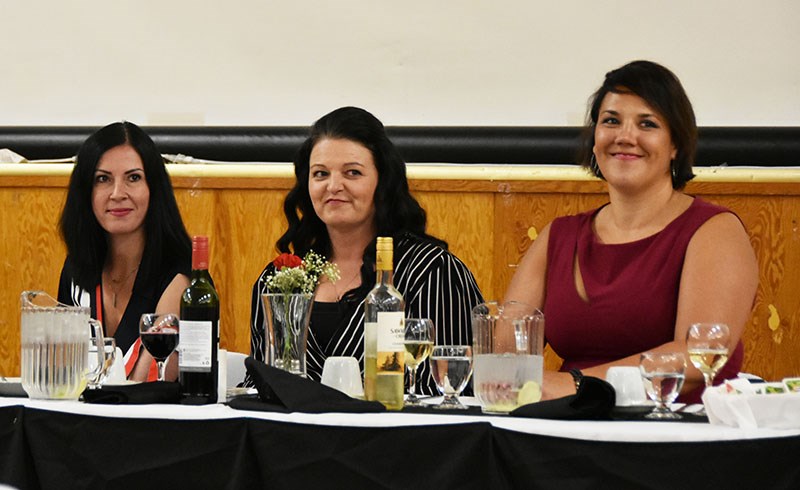Snow Lake’s June 24 evening with Diamonds in the Rough delivered all that it promised and more! A meal second to none, a venue spiffed up so nice you forgot where you were, a gala-like atmosphere ... and the diamonds? Well, they sparkled and shone.
Diamonds in the Rough (DITR) is an all-female mine rescue team, consisting of Kari Lentowicz, Jodi Brasch, Renae Campbell, Janie Blanchette, Naomi Fugle, Jennifer Hingston, Fanny Laporte, and Heather MacKenzie. They come from places such as Val d’Or and Montréal, Que.; Denare Beach, Sask.; Yellowknife, N.W.T.; and Snow Lake and work for companies like Hudbay Minerals, Cameco Corporation, Agnico Eagle, Levitt Safety, and Rio Tinto’s Diavik Diamond Mine.
Mine rescue workers, in general, are mainstays within the safety culture of the Canadian mining industry. Their job, like that of any other rescue personnel, requires them to “run into dire situations as others run out.” Although they are seldom called upon to do so, they can be tasked with putting out underground fires and dealing with a myriad of emergencies within an industry that has a secluded work environment, large equipment and explosives. “Hoping for the best and preparing for the worst” sees most teams train regularly and practise what they’ve learned during regular mine rescue competitions. Formal competitions are held locally, provincially, nationally and internationally. Teams compete for titles and trophies, but the skills they hone are for the safety of workers under the headframe back home.
The format the evening took was threefold … each of the three DITR members on hand took their turn at the podium and explained what their personal experiences with the team, and mine rescue in general, were like. However, before that got underway, acknowledgements and thanks were allotted by organizer Kim Stephen and Hudbay Women’s Network’s Nicole Rollins; as well, greetings were conveyed by Mayor Peter Roberts and MLA Tom Lindsey. Prior to getting underway, a cheque for $500 from Hudbay Women’s Network was presented to the team … Stephen was hoping to add to that amount once bills were cleared.
Kari Lentowicz was the first Diamond to speak. With 12 years of mine rescue experience, and being the first certified female mine rescue trainer in Saskatchewan, Ms. Lentowicz is no stranger to breaking down barriers or sizing up competition. She is credited with conceptualizing, creating and organizing the DITR team. She gave an overview of her career in the mining industry, focusing on the issues and barriers that women face in what is seen as a male-dominated occupation. Lentowicz also went into detail on how the Diamonds team was conceptualized and formed.
“I don’t know how many of you are aware, but 1978 was the first time women were legally allowed to work in mining in Canada,” she said, noting that allowances were made three times in the case of war. She spoke of how the industry tolerated women at the outset of legality, to a point now, where many companies see the benefits of employing females and are seeking them out. Lentowicz noted that 17 per cent of the current mining industry workforce in Canada is made up of women; however, only three per cent of the Canadian mine rescue body is female. “That doesn’t match up; our goal is to get to that,” she said.
Jodi Brasch is an underground scoop tram operator at Lalor Mine and was the first women in over 40 years to work in an underground environment in Hudbay’s Snow Lake mines. As well, she has competed as a member in local, provincial and international mine rescue competitions. Brasch began by introducing the Lalor Mine manager, Chris Adams and commended him on his inclusive management style, before going into a summary of her personal quest to become a miner, like her father and grandfather before her. Brasch hired on in 2012 with Hudbay Minerals and began working underground at Lalor as an electrician’s helper. She declined an electrical apprenticeship in order to continue working towards becoming a miner. She went from the helper position to the rock breaker, then to “nipping” on the boom truck. “I watched a lot of men slide by me into other positions and carry on to other jobs, with less time and experience than me,” she said. “I’ve stood my ground and never stopped asking, relentlessly, when was it my turn to move up?” Eventually she moved up to a 60-ton truck driver and from there to a scoop tram operator … she continues to push for a job as a miner. Nevertheless, along her way she became involved with mine rescue and fell in love with the training and competition that has taken her to international competition and accolades.
The final speaker, Renae Campbell, is a field sales specialist with Levitt Safety; she has acted as a judge at local, provincial, and national mine rescue events and has worked in mine rescue since 2012. Ms. Campbell gave an interesting synopsis of mine rescue, the positions within it, and the special people who gravitate towards the positions. “Mine rescue teams have bravely responded to incidents and disasters throughout Canada for more than a century,” said Campbell. “An interesting piece of information… in 1933, Hudson Bay Mining and Smelting (precursor to Hudbay Minerals) was the first mining company in Manitoba to have suitable mine rescue equipment and 10 certified mine rescue personnel.”
Ms. Lentowicz closed giving an overview of their ground-breaking attendance at the 11th International Mines Rescue Competition (IMRC) in Ekaterinburg, Russia last Sept. 22-29. There, they were the first “women only” team to compete at an international level and the first-ever females to work in the underground environment of Russia.
The overall message of the evening was basically, “Never let anyone tell you that you can’t do something just because you are a woman.” That conception is a fallacy, and these ladies proved it, not only in spades … but in Diamonds!




